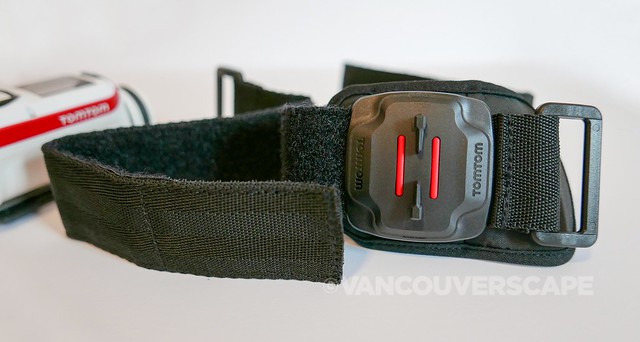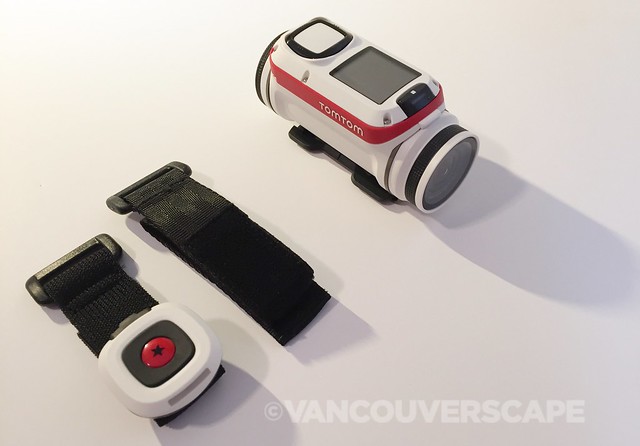Last week, I posted an introduction to a new video camera I’ve been playing with over the holidays: the TomTom Bandit. Here’s the rest of the review, following several test runs with the camera shooting both still images and video.
Test Drive
The camera’s going to be a lot easier to use for those who are already familiar with TomTom products. It’s a small learning curve for the rest of us, but after awhile, you’ll get the hang of how to choose various options, found on each side of the square as you toggle left, top, right, and bottom, much like a joystick. In addition to screen options, you can also view remaining photos, recording time and battery life in addition to GPS and micro SD status.
Only a couple of days in, I got an few error messages saying “Can’t write to the SD card” with a sad face icon. I had the option to fix the issue each time and all seemed OK from that point on. I took the Bandit out to Vancouver’s Stanley Park on a cloudy winter day to get a realistic impression of what the camera would do under less-than-optimal conditions.
Having the camera right on my wrist allowed for remote control operation with the other hand. It’s a simple matter of pushing the red star button on the back of the camera to start creating some highlights.
[Regular speed and Slo-Mo video settings]
While the footage I shot wasn’t the most compelling, it gave me an idea as to how the Bandit works. Once you open the mobile app and pair it with the video camera, you can see created highlights, create new ones on the fly and prep for the ultimate step: shaking the phone to create a story using the best moments of your adventures.
Then it’s a matter of choosing to keep background sound or add a soundtrack (courtesy of your phone’s music library). This creates the problem of using royalty-free tunes. When I work with GoPro Studio and iMovie, I’m able to access YouTube’s free music library and listen to tracks usable for my videos, something that might one day be possible via the mobile app but pretty time-consuming to select and incorporate into the final video.
I find that the shuffling part is pretty fun and the results can be pretty impressive (and yet sometimes not make sense due to the app’s idea of proper order) but the limitation on viewing and editing from a tiny phone screen coupled with legal music issues makes me wonder whether this product has staying power down the road.
The Bandit feels pretty sturdy in the hand and its navigation system, once you get used to it, is pretty simple. This kind of gadget would be perfect for travel buffs who want to create fun, quick video clips on the fly without fuss.
[Video created using iPhone and Bandit app]
On the plus side, you don’t need to take off the case to charge the battery. On the minus side, I found it frustrating to pair with the iPhone app. Sometimes wifi would find it, many more times, not. I’d carefully set up a time-lapse video for 15-second intervals on the TomTom, finally opened the Bandit app on the phone and hit record. 40 minutes into my project, I was finished and turned off the record button on the phone. It wouldn’t turn off that way, so I manually stopped recording via the camera.
[A successful Night Lapse Mode video, recorded then processed in iMovie at 75% of original speed]
And then, frustration: I’d only captured 15 seconds of continuous footage (indoors, revealing poor video quality – hardly 1080p) and no time lapse whatsoever!
I tried one more time to set the time lapse function, this time via the camera itself (first using the app’s viewfinder to set up the shot). Success! Lesson learned: don’t always rely on the app to get the job done.
Accessories
The Bandit remote control comes with two velcro bands. Wear it around your wrist or attach it via the velcro to a backpack or other peripheral. Though splash-proof, the remote can’t be submerged in water so if you’re taking the Bandit snorkeling or diving, consider you’ll have to start and stop the camera while wearing the wrist mount that also comes with a couple of different-sized bands.
The remote control uses a button cell CR2032 battery, something to consider if you’ll be using the remote a lot or travelling to a remote location (pardon the pun) where that type of battery may not be readily available.
You can also highlight a video using the remote, but if you miss a memorable moment, it can always be added when you view it in the mobile app. The highlight’s position and duration can also be adjusted using both methods.
Once you’ve paired the remote to the Bandit, you won’t need to do it again.
If you’re looking for a case to stow the Bandit, Lowepro’s Tahoe 30 fits it (and the remote with wrist strap) perfectly. It’s currently out of stock on Lowepro’s site but I found it on Best Buy’s Canadian site.
Conclusion
While the Bandit’s big marketing push is the Create a Story function using the iPhone/Android app, the real beauty is the ability to create 4K cinematic quality video footage. I couldn’t help but think that the product’s trying hard to be two things at once: a high-end portable action video camera AND a quick and easy way to create and upload low quality video to your fave social sharing site.
I’d like to see the charging cable included in future editions of the Bandit. As well, it would be great to be able to build videos without having to “think” and create highlight tags in order to use the Create a Story function. This is a very ambitious release for a company that’s known for GPS devices and not for action video cameras. The camera may be ready for prime time, but the app leaves much to be desired (my iPhone has the latest iOS installed too).
It’ll be interesting to see what the future holds for the Bandit. TomTom’s priced the Bandit at CAD $500 (US $400). Add $100 for the premium pack mentioned in part one of this review.



































